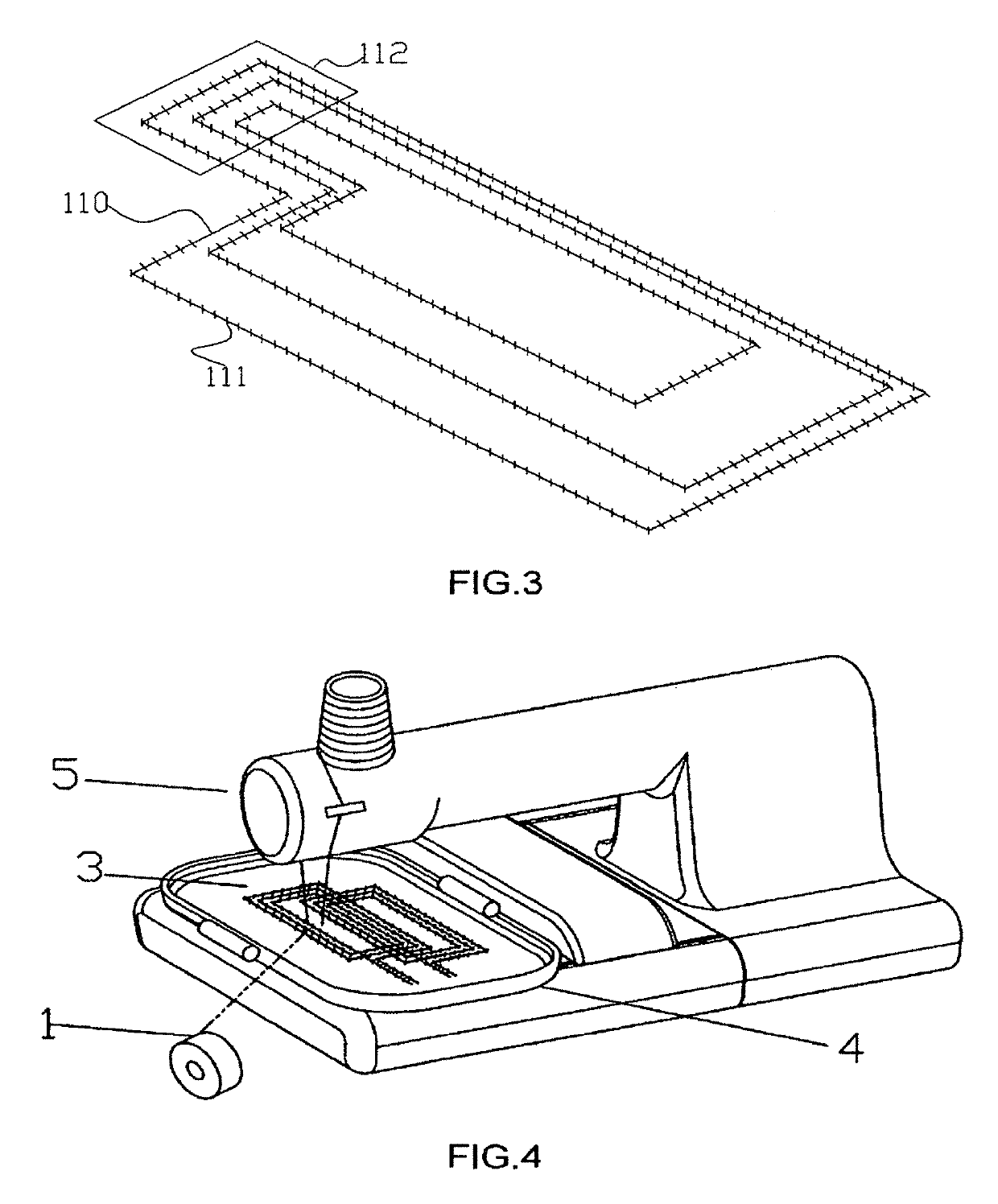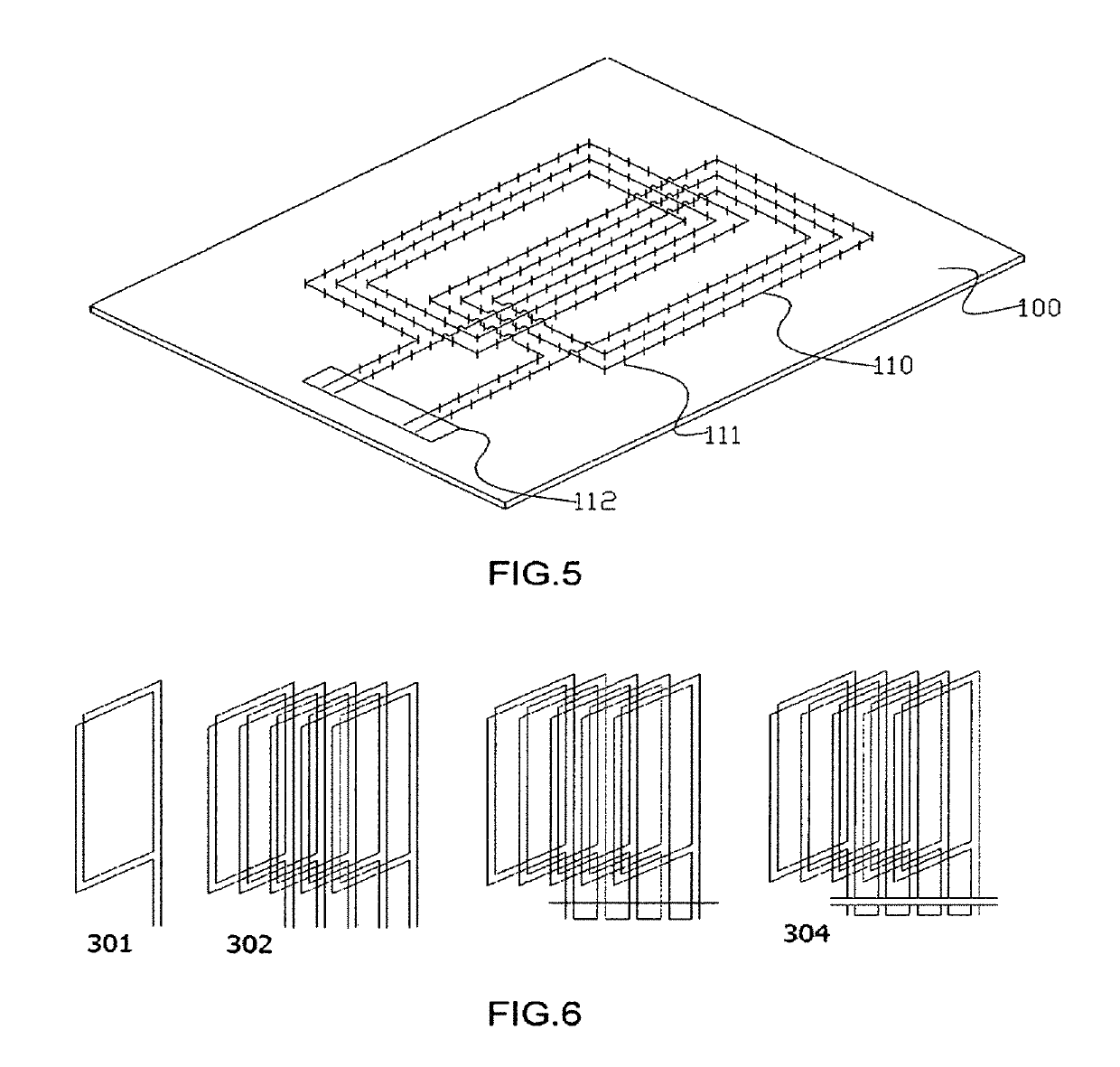Method for fabricating an electromagnetic induction digitizer antenna board
a technology of electromagnetic induction and antenna boards, applied in the field of antenna boards, can solve the problems of difficult realization, low yield rate, and difficult maintenance, and achieve the effects of low yield rate, thin electronic structure, and high production cos
- Summary
- Abstract
- Description
- Claims
- Application Information
AI Technical Summary
Benefits of technology
Problems solved by technology
Method used
Image
Examples
first embodiment
[0049
[0050]FIG. 1 is a schematic diagram illustrating a computer-aided embroidery machine outputting a conductive wire and a binding thread. Referring to FIG. 1, according to an embodiment of the present invention, a method for fabricating an electromagnetic induction digitizer antenna board. The method includes the following steps. At first, a flat substrate for attaching with an electromagnetic induction coil is prepared, wherein the substrate is adapted for being holed with through holes. The substrate can be adaptively selected from papery material, leathery material, fabric material, weaving textile material, artificial leathery material, and plastic material. Then, a consecutive wire leading-out terminal is provided at one side of the substrate for configuring an electromagnetic induction coil. The consecutive wire leading-out terminal is adapted for outputting a conductive wire therefrom. The consecutive wire leading-out terminal outputs and coils to configure the electromagn...
second embodiment
[0051
[0052]FIG. 2 is a schematic diagram illustrating a quilt sewing machine 130 outputting a conductive wire and a binding thread. Referring to FIG. 2, similar to the first embodiment, the quilt sewing machine has a surface thread output terminal or a bottom thread output terminal. According to one aspect of the embodiment, the surface thread output terminal serves as the consecutive wire leading-out terminal to output and coil the electromagnetic induction coil, and correspondingly the bottom thread output terminal serves as the binding thread output terminal to output the binding thread for binding and fixing the conductive wires. According to another aspect of the embodiment, the bottom thread output terminal serves as the consecutive wire leading-out terminal to output and coil the electromagnetic induction coil, and correspondingly the surface thread output terminal serves as the binding thread output terminal to output the binding thread for binding and fixing the conductive ...
third embodiment
[0053
[0054]FIG. 3 is a schematic diagram illustrating a single-needle single-thread chain-stitch sewing machine outputting a binding thread. Referring to FIG. 3, the single-needle single-thread chain-stitch sewing machine has a surface thread output terminal but does not need bottom threads. A mechanical arm having a wire output opening is provided serving as the conductive wire leading-out terminal, and the surface thread output terminal of the single-needle single-thread chain-stitch sewing machine serves as the automatic conductive wire binding mechanism. The wire output opening outputs the conductive wires and configures the electromagnetic induction coils 110, and the surface thread output terminal of the single-needle single-thread chain-stitch sewing machine outputs the binding threads 111 to bind and fix the electromagnetic induction coils 110. The wire output opening moves together with the machine head of the single-needle single-thread chain-stitch sewing machine along wi...
PUM
 Login to View More
Login to View More Abstract
Description
Claims
Application Information
 Login to View More
Login to View More - R&D
- Intellectual Property
- Life Sciences
- Materials
- Tech Scout
- Unparalleled Data Quality
- Higher Quality Content
- 60% Fewer Hallucinations
Browse by: Latest US Patents, China's latest patents, Technical Efficacy Thesaurus, Application Domain, Technology Topic, Popular Technical Reports.
© 2025 PatSnap. All rights reserved.Legal|Privacy policy|Modern Slavery Act Transparency Statement|Sitemap|About US| Contact US: help@patsnap.com



